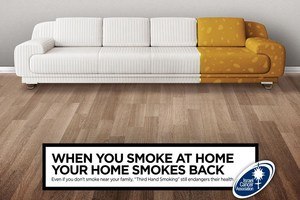Have you ever wondered why, if you go into a room where someone has been smoking even a long time ago, there’s a horrid stink?
Second-hand smoke
Now we have the answer. You’ve probably heard of second-hand smoke. It consists of the smoke emitted from the lit end of a smouldering cigarette mixed with the fumes breathed out from a smoker’s lungs. This chemical soup is made up of fine particulate matter and what are called volatile organic compounds, and there’s no doubt that breathing it can cause cancer in non-smokers living in the same households as smokers.
But that’s not the only problem. Intrepid researchers from San Diego State University (Tob Control 2017;26:548-556) have discovered that:
Second-hand smoke is diluted through mixing with the ambient air, and it spreads to adjacent rooms, hallways and floors of a building, it interacts with the physical environment and is heavily adsorbed onto surfaces and accumulates in dust. (Paraphrased)
Third-hand smoke
It gets worse. Second-hand smoke after a few of hours undergoes chemical and physical changes and forms a reservoir of poisons. This is called third-hand smoke:
[It] penetrates deep into carpet padding and upholstery, infiltrates closed cabinets, closets and drawers, and coats every available microsurface of an indoor environment.
And worse. If second-hand smoke is regularly generated over long periods, such as in the homes or cars of daily smokers, third-hand smoke may persist for months and can thus be absorbed through the skin of children and other non-smokers. Clearly, this is not good for anyone’s health. Further, the most abundant poison in third-hand smoke, nicotine, over time breaks down into other potentially harmful compounds. (I’ve written about this problem before, in relation to airport smoking lounges.)
This could be one of the reasons why many smokers find it so hard to quit. After the last cigarette is extinguished, exposure to nicotine and other tobacco smoke poisons in third-hand smoke may persist in a smoker’s home for months.
Prevention or cure?
What to do about it? The above-mentioned article tells us:
Full remediation might include washing, removal, or replacement of carpets, upholstery, drapes (curtains), clothes, blankets, mattresses, etc., extensive vacuuming to remove accumulated dust deposits and washing of all surfaces (cabinets, furniture, doors, walls, ceilings) to remove surface deposits. In homes of long-term heavy smokers, this could even require replacement of third-hand smoke reservoirs as gypsum board (drywall) and ceiling tiles. Obviously, this would be very expensive.
What is also obvious is that smokers, if they must smoke, should not do it indoors or in cars, but only in the open air.
Poor smokers! No wonder they feel persecuted.
The solution
There is, however, a simple solution to these problems: stop smoking and the third-hand smoke will eventually dissipate.
Keeping this information in mind, rather than letting it be an additional burden and a reason (or excuse) for failing to quit, depending on one’s attitude, it could be an additional incentive to quit.
How to develop a new attitude to smoking so that you won’t want to do it anymore, is explained in the Symonds Method.
Text © Gabriel Symonds


I am a non smoker but lived with my dear mum for 54 years. Mum smoked and the house smelt of it. Sadly mum passed away and now my new home smells sweet as I use pot pourri and regularly use fragrance in disinfectant. I believe that homes become damaged through smoking in fact buying a car someone smoked in depreciates the value of it. I do believe that 2nd and 3rd hand smoke has affected my health as I run and exercise regularly. I get chesty and phlegm build up easily. I used to think because I sleep on my back but believe it is the result of exposure to smokers. Am I correct in my interpretation?
Kindest regards Adrian
Thank you for your message.
I am sorry to hear of the loss of your mum.
It is possible your current health problems are connected with having lived with a smoker for many years, but since your home is now smoke-free, one would expect your symptoms gradually to improve. Nonetheless, it would be advisable to see a doctor to have a proper diagnosis made and be given treatment if needed.